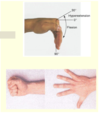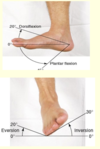MSK 3 Flashcards
Temporomandibular Joint: Normal range of motion test
3 finger insert test
1
- __________ are hard, bony outgrowths or gelatinous cysts on the proximal interphalangeal joints (the middle joints of fingers or toes.)
- Sign of ___________

Bouchard’s nodes=PIP
Osteoarthritis

2
- _________ are hard or bony swellings that can develop in the distal interphalangeal joints (DIP) (the joints closest to the end of the fingers and toes)
- Sign of ___________

- Heberden’s nodes=DIP
- Osteoarthritis

1
- It results from hyperflexion of the extensor digitorum tendon
- Injury of the extensor digitorum tendon of the fingers at the distal interphalangeal joint
- Usually occurs when a ball, while being caught, hits an outstretched finger and jams it
- Inability to extend finger

Mallet Finger
Hyperflexion at DIP (extensor digitorum tendon)

2
- Presents with flexion of the PIP and hyperextension of the DIP.
- PIP=flexion
- DIP=hyperextension
- May affect one or more fingers, including the thumb.
- Active flexion results in being “stuck” until person passively extends finger
- PIP joint will not straightened under its own power (actively) but can be straightened by the other hand (passively). In addition the end joint of the finger (DIP joint) over straightens and will not bend (flex) fully.
- Keyword: “POP”
- Generally caused by a forceful blow to the top (dorsal) side of a bent (flexed) middle joint of a finger or a deep cut.
- May also be caused by Rheumatoid arthritis

Boutonniere (“button hole”) deformity/Trigger finger

3
- Develops with hyperextension of the proximal interphalangeal (PIP) joint and flexion of the distal interphalangeal (DIP) joint.
- PIP=hyperextension
- DIP=flexion
- May affect one or more fingers but not the thumb.
- Occurs in about 50 per cent of rheumatoid arthritis (RA) cases

Swan-neck deformity

“Squeeze-Test” (MTP/MCP)
- Indicates Rheumatoid arthritis
- Positive squeeze test – where squeezing the hand across the knuckle joints is unduly painful

Signs of Rheumatoid arthritis

- grating, crackling or popping sounds and sensations experienced in the joints or a crackling sensation
- Indication of lost cartilage (sound is bone on bone)
- crepitus
- __________ and _________ will likely display crepitus
- Also common in trauma and is a common sign of ________
- osteoarthritis
- rheumatoid arthritis
- bone fracture
- Presence of increased intra-articular fluid (fluid in the joint)
- Can be blood, synovial fluid, or gout fluid
Joint Effusion
Palpate for warmth utilizing the ____ of the hand
dorsum
Shoulder range of motion
- flexion (180 degrees)
- extension (50 degrees)
- abduction (180 degrees)
- adduction (50 degrees)
- internal rotation (90 degrees)
- external rotation (90 degrees)
(ball and socket joint)

Degree of normal range of motion:
- shoulder flexion
180 degrees
(same as abduction)

Degree of normal range of motion:
- shoulder hyperextension
50 degrees
(same as adduction)

Degree of normal range of motion:
- shoulder abduction
180 degrees
(same as flexion)

Degree of normal range of motion:
- shoulder adduction
50 degrees
(same as hyperextension)

Degree of normal range of motion:
- shoulder external rotation
90 degrees

Elbow range of motion
- Flexion (160 degrees)
- Extension (180 degrees)
- Pronation (90 degrees)
- Supination (90 degrees)

Degree of normal range of motion:
- Elbow flexion
160 degrees

Degree of normal range of motion:
- Elbow extension
180 degrees

Degree of normal range of motion:
- Elbow supination
90 degrees

Degree of normal range of motion:
- Elbow pronation
90 degrees

Degree of normal range of motion:
- shoulder internal rotation
90 degrees

Identify

- Olecranon bursitis
- inflammation of the fluid filled sac of the elbow joint; NOT INFECTION
- No actual effusion in the joint; only the bursa
- Note that this is a mobile “ball”
- Due to trauma
- May get cellulitis
Wrist range of motion
- Flexion (90 degrees)
- Extension (70 degrees)
- Radial deviation (toward thumb) (20 degrees)
- Ulnar deviation (toward pinky) (55 degrees)

Degree of normal range of motion:
- Wrist flexion
90 degrees

Degree of normal range of motion:
- Wrist extension
70 degrees

Degree of normal range of motion:
- Wrist radial deviation
20 degrees
(toward thumb)

Degree of normal range of motion:
- Wrist ulnar deviation
55 degrees
(toward pinky)

Finger range of Motion
- Flexion (MCPJ) (90 degrees)
- Hyperextension (MCPJ) (30 degrees)
- Abduction
- Adduction
- Opposition (thumb)

Degree of normal range of motion:
- Finger (MCPJ) Flexion
90 degrees

Degree of normal range of motion:
- Finger (MCPJ) hyperextension
30 degrees

Identify the thumb movement

flexion of thumb

Identify the thumb movement

extension of thumb

Identify the thumb movements

- Adduction of thumb (top arrow toward fingers)
- Abduction of thumb (bottom arrow away from fingers)

Identify thumb movement
Opposition of thumb
Thumb range of motion
- Flexion
- Extension
- Abduction
- Adduction
- Opposition

Identify
- condition in which the knees angle in and touch each other when the legs are straightened

Genu Valgum “knock knees”
Identify
- condition in which the knees of an affected individual are wide apart, while the ankles and feet are together when he/she stands up.
- lower leg is angled inward (medially) in relation to the thigh’s axis, giving the limb overall the appearance of an archer’s bow. Usually medial angulation of both lower limb bones (femur and tibia) is involved.

Genu Varum “Bow Legged”
- In most children under 2 years old, bowing of the legs is simply a normal variation in leg appearance. In children with physiologic genu varum, the bowing begins to slowly improve at approximately 18 months of age and continues as the child grows. By ages 3 to 4, the bowing has corrected and the legs typically have a normal appearance.
Hip range of motion
- Flexion
- Knee flexed: 120 degrees
- Knee extended: 30 degrees
- Extension (90 degrees)
- Abduction (45 degrees)
- Adduction (30 degrees)
- Internal (medial) Rotation (40 degrees)
- External (lateral) Rotation (45 degrees)

Degree of normal range of motion:
- Hip flexion
- Flexion-knee flexed (120 degrees)
- Flexion-knee extended (30 degrees)

Degree of normal range of motion:
- Hip extension
90 degrees

Degree of normal range of motion:
- Hip abduction
45 degrees

Degree of normal range of motion:
- Hip adduction
30 degrees

Degree of normal range of motion:
- Hip Internal rotation
40 degrees

Degree of normal range of motion:
- Hip external rotation
45 degrees

Knee range of motion
- Flexion (130 degrees)
- Extension (15 degrees)

Degree of normal range of motion:
- knee flexion
130 degrees

Degree of normal range of motion:
- knee extension
15 degrees

Ankle range of motion
- Plantar flexion (45 degrees)
- Dorsiflexion (20 degrees)
- Inversion (30 degrees)
- Eversion (20 degrees)

Degree of normal range of motion:
- Ankle plantar flexion
45 degrees

Degree of normal range of motion:
- Ankle dorsiflexion
20 degrees
(same as ankle eversion)

Degree of normal range of motion:
- Ankle inversion
30 degrees

Degree of normal range of motion:
- Ankle eversion
20 degrees
(same as ankle dorsiflexion)

Toe range of motion
- Flexion
- Extension
Lordosis is a _______ or ______ concavity
- Cervical
- Lumbar

- Lateral inspection
- ___________ refers to an inward (concave) curvature of the cervical and lumbar regions of the human spine.
- Can also refer to extreme curvature in those regions

Lordosis

- Lateral inspection
- _________ refers to the normal outward (convex) curvature in the thoracic and sacral regions
- Can also refer to extreme curvature in those regions

Kyphosis

Kyphosis is a _____ and _____ convexity
- Thoracic
- Sacral

Lordosis is con____
conCAVE

kyphosis is con____
conVEX

Normal Spine
- Cervical spinE is _________
- Thoracic spine is _________
- Lumbar spine is _________
- Sacral spine is _________
- Cervical spinE is conCAVE
- Thoracic spine is conVEX
- Lumbar spine is conCAVE
- Sacral spine is conVEX

POSTERIOR INSPECTION OF SPINE
Symmetry of _______ and ________
- Shoulder height
- Iliac crest
POSTERIOR INSPECTION OF SPINE
When inspecting the spinal column, an upright spinal column should have an imaginary line from _____ through the _______
- C7
- gluteal cleft
__________ is defined as a decrease in the mass of the muscle
muscle atrophy
________ involves an increase in size of skeletal muscle through a growth in size of its component cells
muscle hypertrophy
Identify
- (posterior inspection) a spine that curves to the side

Scoliosis

- ____ is the top of the shoulder
- _____ is the tip of the shoulder
- T1
- T7-T8
It’s common to find a harmless deposit of fat under the skin on the back. This is called ______
lipoma
An abnormal tuft of hair of the back may indicate _______
spina bifida
Spina bifida is a birth defect where there is incomplete closing of the backbone and membranes around the spinal cord.
_________ is a benign, flat, congenital birthmark with wavy borders and irregular shape.
May appear on the backs of infants.
Mongolian spot (congenital dermal melanocytosis)
- ______ is a visible and palpable finding of the spine where the bones are not lined up properly which can be seen and felt by the examiner
- Commonly due to trauma
“step-off”
Cervical spine range of motion
- Flexion (45 degrees)
- Extension (55 degrees)
- Lateral Rotation (70 degrees right and left)
- Lateral bending (40 degrees right and left)

Degree of normal range of motion:
- Cervical spine flexion
45 degrees

Degree of normal range of motion:
- Cervical spine extension
55 degrees

Degree of normal range of motion:
- Cervical spine lateral rotation (right and left)
70 degrees

Degree of normal range of motion:
- Cervical spine lateral bending (right and left)
40 degrees

When performing cervical spine range of motion, you may need to stabilize the ______
shoulders-prevents chest movement
Which cranial nerve?
- As patient to rotate head to one side then apply resistance–> compare to other side
- Have patient shrug shoulders against resistance and compare

Cranial Nerve XI (Accessory)
Nine
Spine range of motion
- Flexion (90 degrees)
- Extension (30 degrees)
- Lateral Bending (35 degrees right and left)
- Lateral Rotation (30 degrees right and left)

Degree of normal range of motion:
- spine flexion
90 degrees

Degree of normal range of motion:
- spine extension
30 degrees

Degree of normal range of motion:
- spine lateral bending (right and left)
35 degrees

Degree of normal range of motion:
- spine lateral rotation (right and left)
30 degrees

When performing spinal range of motion, be sure to stabilize the ________
Hips


